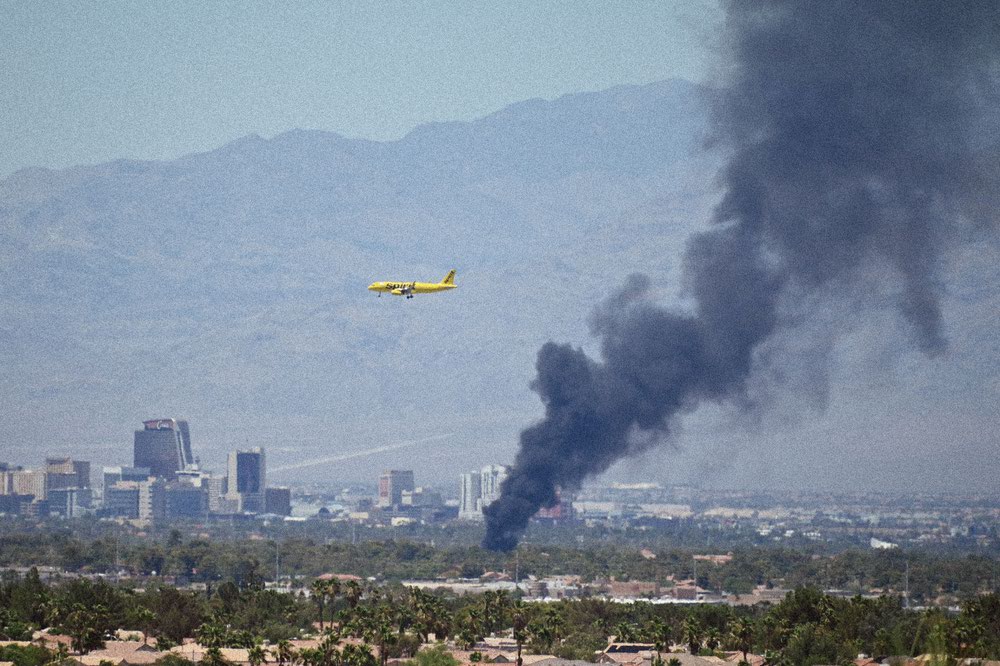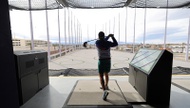There’s a fire out there,” someone behind me says.
A number of us walk to the windows. The Weekly offices have a panoramic view of the Las Vegas Valley, from southernmost Enterprise to Frenchman Mountain, with the entirety of the Strip at its center. And whenever a plume of black smoke goes up somewhere in that broad vista, I join my coworkers in attempting to guess at its point of origin. “That’s somewhere in Winchester,” I’ll say. Or “that’s over by the IKEA.”
Often, though, that smoke is rising from Downtown Vegas. And before I say anything to anyone, I take a moment to make sure that smoke isn’t coming from my neighborhood, because I’ve lived Downtown for 10 years, and I know well that it has lots and lots of old, charming and dangerously flammable buildings—many of which are currently sitting empty and boarded-up.
Downtown fires were a regular thing last year, as constant as the seasons. On June 7, the roof of Fremont Street’s 72-year-old Lucky Motel caught fire and collapsed. On August 29, an empty commercial building at Third Street and Charleston Boulevard burned; it was leveled shortly after to prevent its collapse. The Historic Westside’s Town Tavern/Tokyo Casino building, a 68-year-old structure, was completely decimated in an October 13 blaze. An early-morning December 29 fire consumed another vacant commercial building on Commerce Street, at the north end of the Arts District. And those are just the fires that were severe enough to make news, or be seen from my office window.
The City of Las Vegas is very particular about buildings left vacant for extended periods of time. The rules of their “Registration and Maintenance Program for Vacant Properties” are clear and exact, this one among them: “Specified property shall be maintained in a secure manner so as not to be accessible to unauthorized persons. Doors of all kinds, windows, gates and other openings that make the property accessible must be closed and locked... Broken windows must be reglazed or boarded.”
Missy Braman, senior property manager for Dapper Companies, keeps Dapper’s vacant Downtown properties—which include the Huntridge Theater, whose full renovation is scheduled to begin this year—in line with that City ordinance. She says it’s never as easy as boarding up the windows and doors of a vacant space when you’re dealing with people who feel strongly motivated to get inside.
“It may look like it’s boarded up, but [trespassers] have tools,” she says. “They will actually take off your boards and put them back on, but with hinges on them. They can create doors, and you don’t even know it.”
That’s one of the biggest problems with ordinances like these: They’re meaningless to people who don’t read them or have compelling reasons not to read them. They’re meaningless to vandals who can’t resist an easy target; meaningless to the people shooting off illegal fireworks in Downtown year-round; meaningless to Vegas’ many unhoused people, who are looking for badly needed shelter against summer heat or winter cold; and they’re especially meaningless to the desert sun, which has been randomly setting things on fire in this Valley since long before we moved in.
The vulnerability of these buildings is a constant concern for property owners like Dapper, which goes above and beyond the City’s requirements for empty buildings with working sprinkler systems, surveillance cameras and round-the-clock security patrols … and to Downtown residents like me, who live next door to, and in trepidation for, all this historic kindling. But it’s alarmingly easy to overlook the other vulnerable entity in this set of circumstances: the trespassers themselves, who easily could be killed by their own actions. Case in point: The aforementioned August 2023 fire trapped three people, who were saved by fire crews; one was hospitalized for smoke inhalation.
Las Vegas Fire & Rescue can’t always prove what caused a fire in a vacant building, says the department’s community engagement administrator Jordan Moore. With vacant buildings and late night or early morning blazes, it’s not like witnesses are abundant. Or willing to wait around.
“In many cases, by the time staff arrives, everyone within the structure has vacated,” says Moore. But she adds, while the exact numbers can’t be conclusively proven, that “a percentage of abandoned building fires are started due to trespassers” who are trying to cook food or warm themselves.
Some vacant buildings are particularly attractive targets, forcing property owners to take stronger measures. Before she went to work for Dapper Companies, Braman worked with the Tony Hsieh-led Downtown Project (DTP). She notes that one of Dapper’s current Downtown properties, the 74-year-old Mission Linen building next to Arts Square, once belonged to DTP.
“I remember the first time we walked in; it was a village. We got chased out with a knife,” she says. Metro was called to evacuate the squatters, and DTP took care of the rest: “We ripped everything out. We had to rip everything out; there was too much you could burn.”
Braman’s vigilance continues today with Dapper Companies, as she works to protect the historic buildings the developer is in the process of renovating. The Huntridge Theater is a treasure to most locals, but to some, she says, it’s a constant temptation.
“We did have a fire two years ago at the Huntridge. It was about two o’clock in the morning. They cut a hole, a little mouse-hole, in [the building] to start a fire. What for? I don’t know,” she says.
The building’s sprinklers quickly doused the fire, and Dapper increased its security patrols from 12 hours daily to 24. “That’s the only thing that’s really saved us,” Braman says. “It’s just constant eyes.”
If you read this far hoping for solutions, I’m afraid I have to disappoint you. There’s no easy, catch-all solution to this problem, because it’s actually a bunch of big, terrible problems that need to be solved first. Las Vegas’ unhoused need to be cared for and housed, so that they won’t be tempted to take up residence in tinderboxes. Property owners need to keep a vigilant eye on their vacant buildings, to make certain they remain safely secured. And “the community can always help by being the city’s eyes and ears,” says Moore, suggesting that residents report suspected squats to City of Las Vegas code enforcement before it becomes a 911 call.
And while Downtown Vegas has a concentration of those vacant buildings, the same holds true for unincorporated Clark County, Henderson and North Las Vegas, too. From experience, I can tell you that the Valley’s next plume of smoke could come from anywhere.
Click HERE to subscribe for free to the Weekly Fix, the digital edition of Las Vegas Weekly! Stay up to date with the latest on Las Vegas concerts, shows, restaurants, bars and more, sent directly to your inbox!





